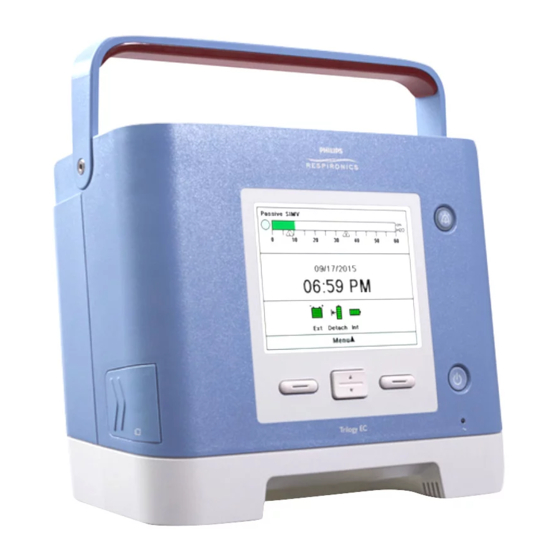
Summarization of Contents
Chapter 1: Introduction
Trilogy 100 & Trilogy 200 Ventilators Intended Use
Specifies intended use for Trilogy 100 & 200 ventilators for patients weighing at least 5 kg.
Trilogy 100 & Trilogy 200 System Overview
Overview of Trilogy 100 & 200 features, including pressure and volume modes, and power sources.
Service/Technical Support Statement
Contact information for customer support in the USA, Canada, and International.
Chapter 3: Specifications, Classifications, & System Features
Environmental Specifications
Details operating and storage conditions for temperature, humidity, and atmospheric pressure.
Electrical Specifications
Lists AC voltage source, battery specifications, protection types, fuses, and power consumption.
Control Accuracy
Details accuracy specifications for various control parameters like IPAP, EPAP, Tidal Volume, and Breath Rate.
Chapter 4: Theory of Operation
AC/DC Power Supply
Explains the universal AC input, output voltage, topology, and isolation of the power supply.
Power Management Board
Describes the board that controls four power sources and manages power distribution.
Chapter 5: System Setup
Keypad Lock Feature
Explains the feature to prevent accidental changes to device settings by locking navigation keys.
Changing and Viewing Settings in Full Menu Access Mode
Describes how to view and change settings using the menu screens in Full Menu Access mode.
Chapter 6: Troubleshooting & Alarms
Trilogy Ventilator Alarms
Identifies the three types of alarms (High, Medium, Low priority) and informational messages.
Troubleshooting Table
Provides a table correlating device actions, possible causes, and corrective actions for troubleshooting.
Chapter 7: Maintenance
Routine Maintenance
Details periodic checking, cleaning, and replacement of items like air inlet filters and enclosures.
Preventive Maintenance
Outlines preventive service procedures and intervals, including blower hours and dates.
Cleaning and Disinfection Procedures
Provides procedures for cleaning the ventilator exterior and detachable battery pack.
Chapter 8: Repair & Replacement
External Component Removal/Installation
Covers the removal and installation of external components like the detachable battery pack and inlet filter.
Front/Rear/Bottom Enclosure Removal
Details the procedure for removing the front, rear, and bottom enclosures of the ventilator.
Bottom Enclosure Assembly Component Removal/Installation
Illustrates the removal and installation of components within the bottom enclosure assembly.
Chapter 9: Repair Kits
Repair Kit Reference Table
Provides a table listing part numbers, repair kit names, and corresponding page identifiers for ordering.
Chapter 10: Trilogy Testing & Calibration
Trilogy 100 Checkout Procedure
Details the test procedures for Trilogy 100 checkout, including visual inspection and settings tests.
Downloading Trilogy Field Service Application, Trilogy Tool Box Software, and National Instruments DAQmx Software
Guides on downloading essential software for device testing and calibration.
Chapter 11: Tools and Equipment
Common Hand Tools
Lists essential hand tools required for troubleshooting, testing, and repair.
Equipment
Details the required equipment and PC system specifications for performing tests.
Chapter 12: Schematics
Schematics Statement
States that schematics are proprietary, confidential, and intended for administrative use only.















Need help?
Do you have a question about the Trilogy 200 and is the answer not in the manual?
Questions and answers